外研版(2019)选择性必修第二册Unit 3 Times change Developing ideas 课件 (共26张PPT,内嵌视频)
文档属性
| 名称 | 外研版(2019)选择性必修第二册Unit 3 Times change Developing ideas 课件 (共26张PPT,内嵌视频) |
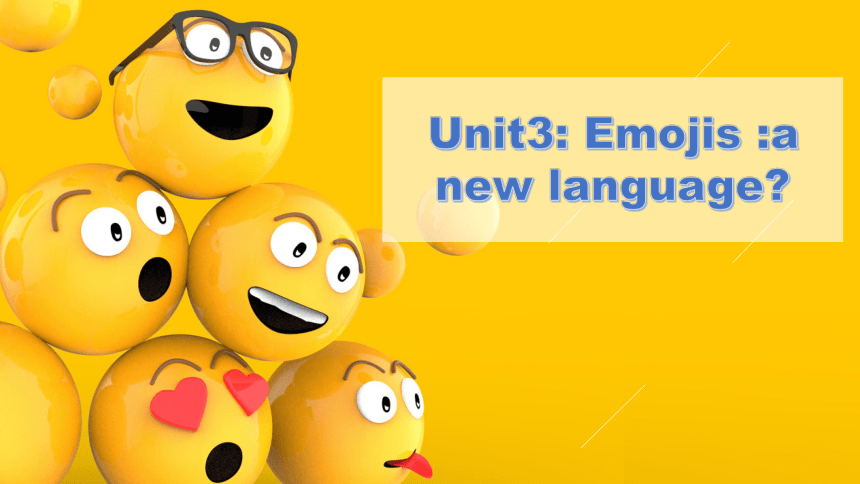
|
|
| 格式 | pptx | ||
| 文件大小 | 73.9MB | ||
| 资源类型 | 教案 | ||
| 版本资源 | 外研版(2019) | ||
| 科目 | 英语 | ||
| 更新时间 | 2023-07-26 16:35:26 | ||
图片预览

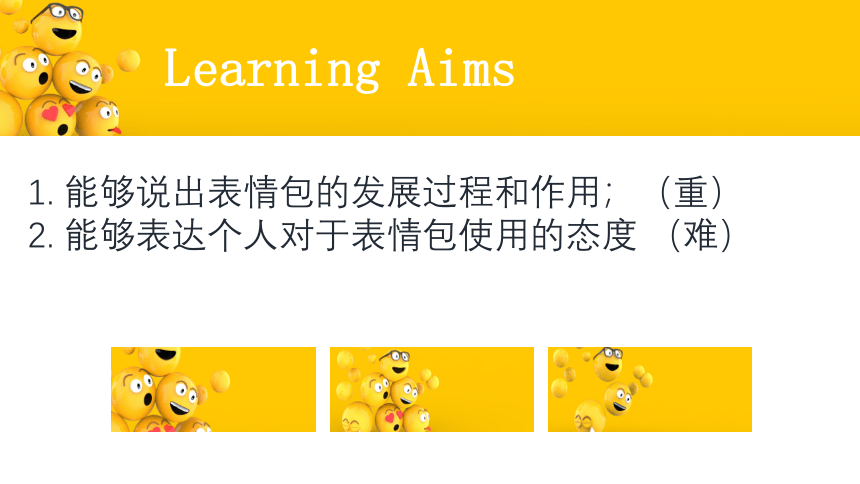
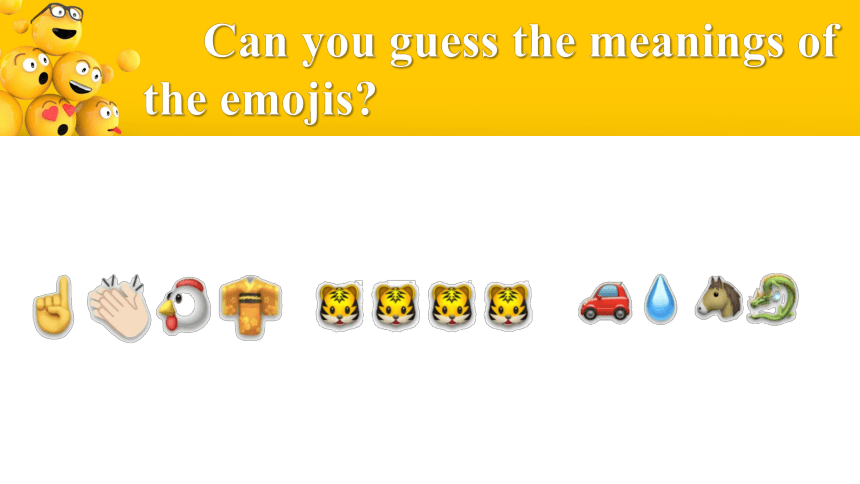
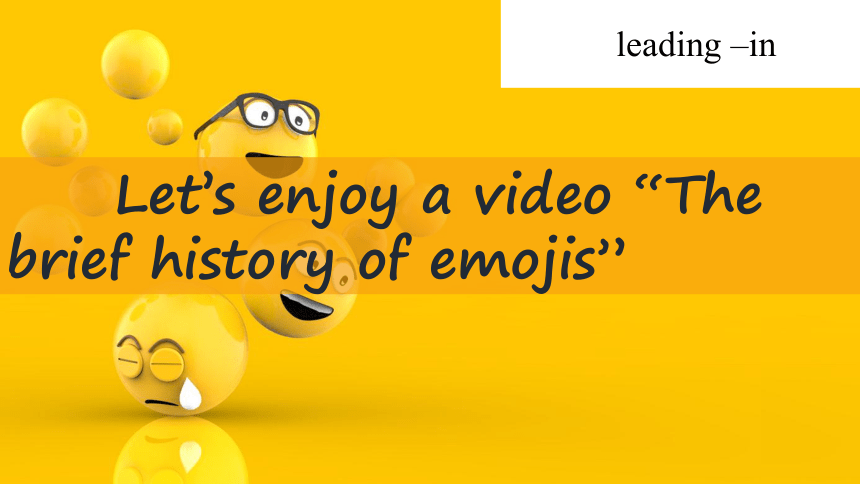
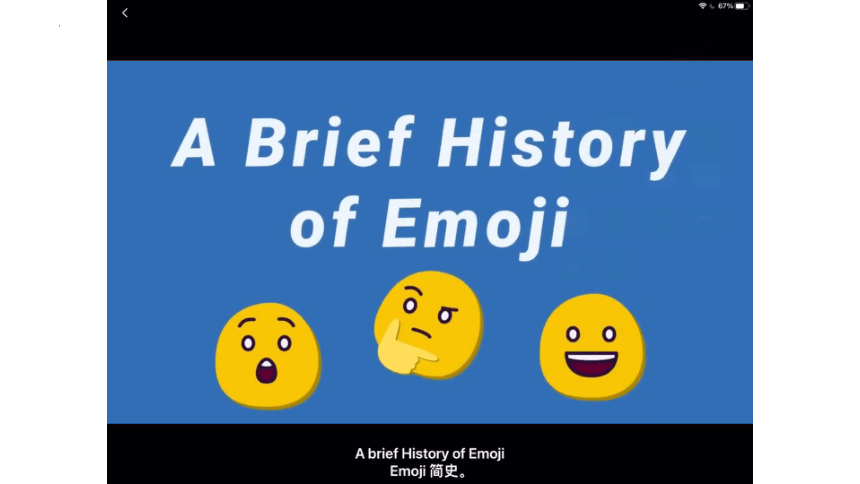

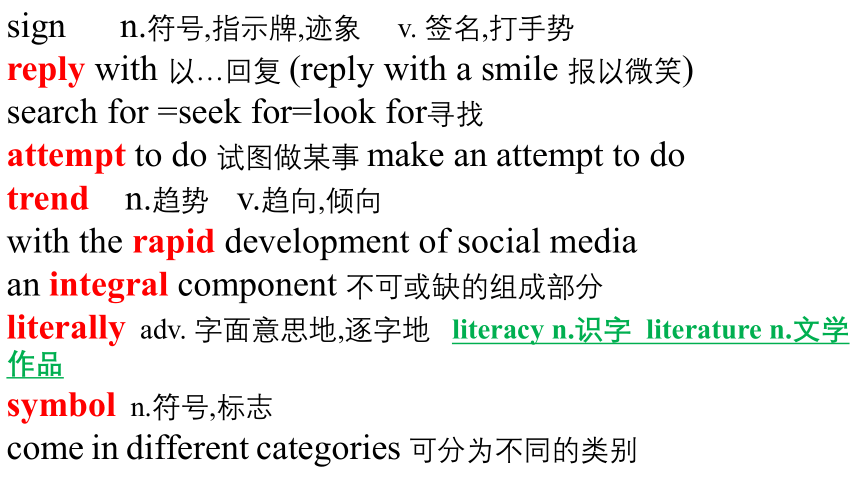
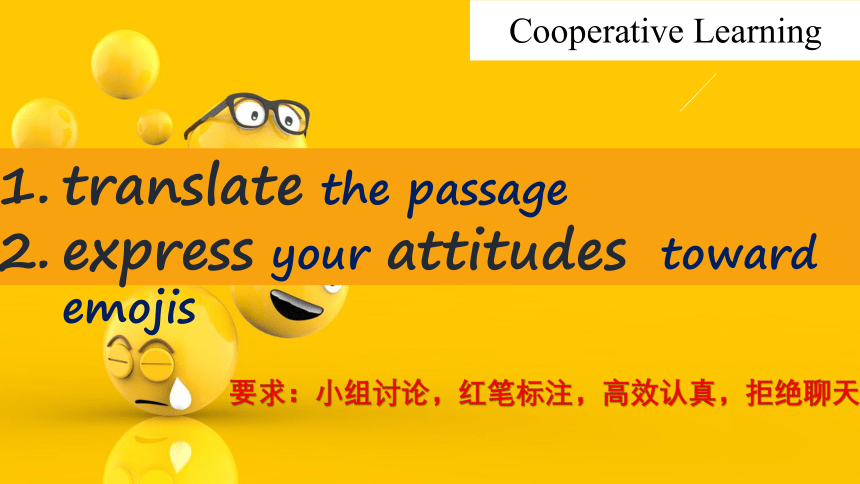
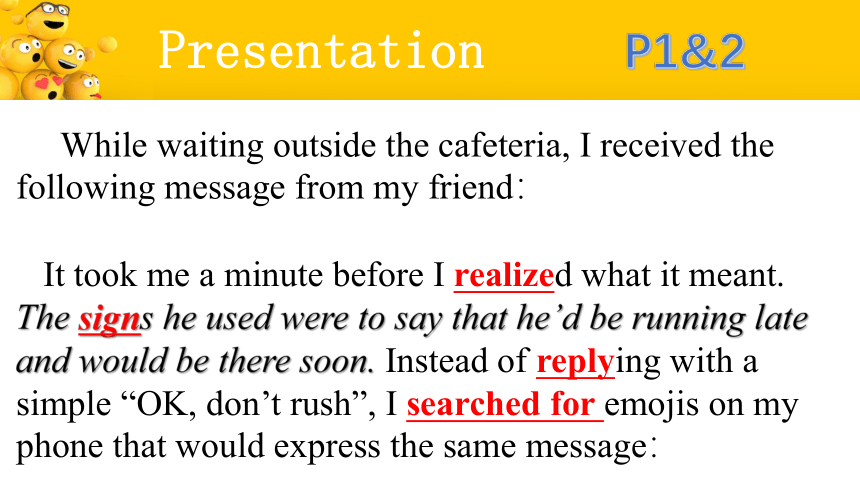
文档简介
(共26张PPT)
Unit3: Emojis :a new language
Learning Aims
能够说出表情包的发展过程和作用;(重)
能够表达个人对于表情包使用的态度 (难)
标题文字添加
The user can demonstrate on a projector or computer, or presentation and make it film to be used in a wider field
标题文字添加
The user can demonstrate on a projector or computer, or presentation and make it film to be used in a wider field
标题文字添加
The user can demonstrate on a projector or computer, or presentation and make it film to be used in a wider field
Can you guess the meanings of the emojis
The user can demonstrate on a projector or computer, or print the presentation and make it film
leading –in
Let’s enjoy a video “The brief history of emojis”
Independent learning 4mins
Read the passage on P32-P33 and finish Q3 on P34
要求:坐姿端正,红笔标划,保持安静
sign n.符号,指示牌,迹象 v. 签名,打手势
reply with 以…回复 (reply with a smile 报以微笑)
search for =seek for=look for寻找
attempt to do 试图做某事 make an attempt to do
trend n.趋势 v.趋向,倾向
with the rapid development of social media
an integral component 不可或缺的组成部分
literally adv. 字面意思地,逐字地 literacy n.识字 literature n.文学作品
symbol n.符号,标志
come in different categories 可分为不同的类别
Cooperative Learning
translate the passage
express your attitudes toward emojis
要求:小组讨论,红笔标注,高效认真,拒绝聊天
While waiting outside the cafeteria, I received the following message from my friend:
It took me a minute before I realized what it meant. The signs he used were to say that he’d be running late and would be there soon. Instead of replying with a simple “OK, don’t rush”, I searched for emojis on my phone that would express the same message:
Presentation
P1&2
Presentation
This was my attempt to follow the trend of communicating with emojis. Emojis are used everywhere,from text messages to emails, blogs and other social media networks. With the rapid development of social media, emojis are becoming an integral component of the language we use to express ourselves.
P3
Presentation
The word “emoji” comes from Japanese, literally meaning “picture character”. Emojis are small symbols representing ideas, emotions or feelings. They come in different categories, such as faces and people, plants and animals, and food and drink.
P4
Presentation
When first introduced in Japan in 1999, emojis were limited to 176 simple designs. Now there are more than 3,000 emojis that expand upon the way in which we communicate. Due to their popularity, the Oxford Dictionaries Word of the Year in 2015 was, for the first time ever, a pictograph instead of a traditional word.
P5
Presentation
In today’s world, emojis have become more and more popular. It seems that emojis have clear advantages over written language. People like them because they add emotional meaning, and are quick and easy to use. In fact, this is similar to the gestures we use when we speak. With a smiling or sad face added to a message or post, your reader can “see” your facial expression while reading your words.
P6
Presentation
Emojis can also help people express their feelings when they cannot find the appropriate words. For instance, if your friend is moving across the country, you may just send them a string of crying faces to express your sadness over your separation.
P6
Presentation
The use of emojis has even spread to classical literature. A Shakespeare series for young readers has taken William Shakespeare’s popular plays and replaced some words with textspeak and emojis. The intention of these adaptations is to make the classics more accessible to young readers. Some people, however, believe that these new versions have taken away the heart and soul of Shakespeare’s plays.
P7
Presentation
As we can see, emojis have a tendency to pop up all over the place. Users of emojis say that they facilitate the way in which we communicate and express ourselves. But this makes others, especially educators, worry that we are losing the ability to communicate properly using the written word, or even the spoken word. After all, how many of us today would rather send a message packed with emojis than make a telephone call
P8
Presentation
Perhaps people will one day choose to communicate in pictures, and forget how to write properly. On that day, emojis will have become a real pictorial “language”. But, for now, maybe it’s best t hat we just enjoy using them.
Improvement
What do you think about the way people use emojis
Improvement
Emojis occasionally used in daily conversation are vivid and interesting in conveying people’s feeling. But if we only use emojis to communicate, I think sometimes it may be very hard for people to understand and it is also a waste of time spending so much time finding proper emojis to express one’s feelings.
Presentation
sign
reply with (reply with a smile 报以微笑)
search for
attempt to do
trend
with the rapid development of social media
an integral component
Para 1-3
Presentation
literally
small symbols representing ideas,
emotions or feelings
category
be limited to
due to the popularity
Para4-5
Presentation
have clear advantages over sth.
be similar to
find the appropriate words
for instance
a string of crying faces
express your sadness over the separation
Para6
Presentation
spread- -
replace…with
intention intend to do sth.
adaptation
be accessible to access
new versions
Para7
Presentation
have a tendency to pop up all over the place
facilicate
the ability to communicate properly using the written word
rather than
be packed with
Para 8
Feedback
The user can demonstrate on a projector or computer, or print the presentation and make it film
While (wait) outside the cafeteria, I received the following message from my friend.
When first (introduce) in Japan in 1999, emojis were limited to 176 simple designs.
While (visit) the city, they received a warm welcome.
Unless (invited) to speak, you should remain silent at the conference.
Though (lack) money, his parents managed to send him to university.
Unit3: Emojis :a new language
Learning Aims
能够说出表情包的发展过程和作用;(重)
能够表达个人对于表情包使用的态度 (难)
标题文字添加
The user can demonstrate on a projector or computer, or presentation and make it film to be used in a wider field
标题文字添加
The user can demonstrate on a projector or computer, or presentation and make it film to be used in a wider field
标题文字添加
The user can demonstrate on a projector or computer, or presentation and make it film to be used in a wider field
Can you guess the meanings of the emojis
The user can demonstrate on a projector or computer, or print the presentation and make it film
leading –in
Let’s enjoy a video “The brief history of emojis”
Independent learning 4mins
Read the passage on P32-P33 and finish Q3 on P34
要求:坐姿端正,红笔标划,保持安静
sign n.符号,指示牌,迹象 v. 签名,打手势
reply with 以…回复 (reply with a smile 报以微笑)
search for =seek for=look for寻找
attempt to do 试图做某事 make an attempt to do
trend n.趋势 v.趋向,倾向
with the rapid development of social media
an integral component 不可或缺的组成部分
literally adv. 字面意思地,逐字地 literacy n.识字 literature n.文学作品
symbol n.符号,标志
come in different categories 可分为不同的类别
Cooperative Learning
translate the passage
express your attitudes toward emojis
要求:小组讨论,红笔标注,高效认真,拒绝聊天
While waiting outside the cafeteria, I received the following message from my friend:
It took me a minute before I realized what it meant. The signs he used were to say that he’d be running late and would be there soon. Instead of replying with a simple “OK, don’t rush”, I searched for emojis on my phone that would express the same message:
Presentation
P1&2
Presentation
This was my attempt to follow the trend of communicating with emojis. Emojis are used everywhere,from text messages to emails, blogs and other social media networks. With the rapid development of social media, emojis are becoming an integral component of the language we use to express ourselves.
P3
Presentation
The word “emoji” comes from Japanese, literally meaning “picture character”. Emojis are small symbols representing ideas, emotions or feelings. They come in different categories, such as faces and people, plants and animals, and food and drink.
P4
Presentation
When first introduced in Japan in 1999, emojis were limited to 176 simple designs. Now there are more than 3,000 emojis that expand upon the way in which we communicate. Due to their popularity, the Oxford Dictionaries Word of the Year in 2015 was, for the first time ever, a pictograph instead of a traditional word.
P5
Presentation
In today’s world, emojis have become more and more popular. It seems that emojis have clear advantages over written language. People like them because they add emotional meaning, and are quick and easy to use. In fact, this is similar to the gestures we use when we speak. With a smiling or sad face added to a message or post, your reader can “see” your facial expression while reading your words.
P6
Presentation
Emojis can also help people express their feelings when they cannot find the appropriate words. For instance, if your friend is moving across the country, you may just send them a string of crying faces to express your sadness over your separation.
P6
Presentation
The use of emojis has even spread to classical literature. A Shakespeare series for young readers has taken William Shakespeare’s popular plays and replaced some words with textspeak and emojis. The intention of these adaptations is to make the classics more accessible to young readers. Some people, however, believe that these new versions have taken away the heart and soul of Shakespeare’s plays.
P7
Presentation
As we can see, emojis have a tendency to pop up all over the place. Users of emojis say that they facilitate the way in which we communicate and express ourselves. But this makes others, especially educators, worry that we are losing the ability to communicate properly using the written word, or even the spoken word. After all, how many of us today would rather send a message packed with emojis than make a telephone call
P8
Presentation
Perhaps people will one day choose to communicate in pictures, and forget how to write properly. On that day, emojis will have become a real pictorial “language”. But, for now, maybe it’s best t hat we just enjoy using them.
Improvement
What do you think about the way people use emojis
Improvement
Emojis occasionally used in daily conversation are vivid and interesting in conveying people’s feeling. But if we only use emojis to communicate, I think sometimes it may be very hard for people to understand and it is also a waste of time spending so much time finding proper emojis to express one’s feelings.
Presentation
sign
reply with (reply with a smile 报以微笑)
search for
attempt to do
trend
with the rapid development of social media
an integral component
Para 1-3
Presentation
literally
small symbols representing ideas,
emotions or feelings
category
be limited to
due to the popularity
Para4-5
Presentation
have clear advantages over sth.
be similar to
find the appropriate words
for instance
a string of crying faces
express your sadness over the separation
Para6
Presentation
spread- -
replace…with
intention intend to do sth.
adaptation
be accessible to access
new versions
Para7
Presentation
have a tendency to pop up all over the place
facilicate
the ability to communicate properly using the written word
rather than
be packed with
Para 8
Feedback
The user can demonstrate on a projector or computer, or print the presentation and make it film
While (wait) outside the cafeteria, I received the following message from my friend.
When first (introduce) in Japan in 1999, emojis were limited to 176 simple designs.
While (visit) the city, they received a warm welcome.
Unless (invited) to speak, you should remain silent at the conference.
Though (lack) money, his parents managed to send him to university.
